Difference between revisions of "Trisetum interruptum"
imported>Volume Importer |
imported>Volume Importer |
||
| (One intermediate revision by the same user not shown) | |||
| Line 39: | Line 39: | ||
|publication year= | |publication year= | ||
|special status= | |special status= | ||
| − | |source xml=https:// | + | |source xml=https://bitbucket.org/aafc-mbb/fna-data-curation/src/200273ad09963decb8fc72550212de541d86569d/coarse_grained_fna_xml/V24/V24_1064.xml |
|subfamily=Poaceae subfam. Pooideae | |subfamily=Poaceae subfam. Pooideae | ||
|tribe=Poaceae tribe Poeae | |tribe=Poaceae tribe Poeae | ||
Latest revision as of 16:21, 11 May 2021
Plants annual, without sterile shoots; tufted. Culms (5)10-40 (60) cm, erect or spreading, mostly glabrous, pilose below the nodes. Leaves basally concentrated; sheaths scabridulous or pilose; ligules 1-2.5 mm, truncate; blades 3-12 cm long, 1-4 mm wide, flat, folded, or involute distally when dry, ascending, glabrous or pubescent, margins frequently sparsely ciliate. Panicles 2-15 cm long, 0.3-1.5 cm wide, often interrupted, at least in the lower 1/3, green or tan; branches short, usually erect to appressed, the spikelets crowded. Spikelets 3-6 mm, often in pairs with 1 subsessile and 1 pedicellate, with 2-3 florets; disarticulation initially above the glumes, subsequently below; rachilla internodes usually 0.8-1 mm; rachilla hairs usually about 0.5 mm. Glumes subequal, 4-5 mm, about as long as the lowest lemmas, smooth or sparsely scabridulous; lower glumes 0.5-1 mm wide, lanceolate or elliptical, 3-veined, acuminate, sometimes apiculate; upper glumes about twice as wide as the lower glumes, elliptical or oblanceolate, acuminate; callus hairs 0.1-0.2(0.5) mm, sparse; lemmas 3-4.5 mm, usually glabrous, sometimes minutely pustulate-scabridulous, apices bifid, teeth to 1.7 mm, awned, awns usually 4-8 mm, arising from midlength to just below the teeth and exceeding the lemma apices, geniculate, twisted basally, rarely 2-4 mm, straight, arcuate, or flexuous; paleas usually 2/3 as long as the lemmas, hyaline; anthers about 0.2 mm. Caryopses 2-3 mm, longitudinally striate, sometimes with a few hairs distally. 2n = 14.
Distribution
Okla., N.Mex., Tex., La., Colo., Ariz.
Discussion
Trisetum interruptum grows in open, dry or moist soil in deserts, plains, arid shrublands, and riparian woodlands, from the southern United States into Mexico. It is often weedy.
Selected References
None.
